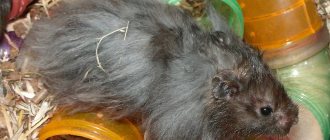The hamster is one of the cutest and friendliest pets. The hilarious behavior of this animal, its funny face and beautiful fur evoke affection in both children and adults.
Those who decide to have a rodent in their home need to study the rules for caring for it in advance. One of the key questions is how to wash a hamster?
Actually, I’m white... Well, that’s how it happened!
Is it possible to bathe a hamster in water?
In most pet stores you can find two breeds of hamsters: Djungarians and Syrians. The rules for caring for them are slightly different, but in general their physiology is similar. Both the former and the latter have natural habitats that are steppes and deserts. Such living conditions have taught small rodents to be very clean; they clean their fur 5–6 times a day, which is why they look neat, even if they are not washed.
Due to their existence in an arid climate, rodents do not tolerate water treatments well:
- Their fur is very thin, making them sensitive to cold water.
- If the water is too hot, your pet may have a heart attack.
- Hamsters can swim, but poorly. Without reaching the bottom, the rodent may panic and drown.
So, back to our question: is it possible to bathe hamsters? It is undesirable to do this, since this is serious stress for the small body of a rodent. However, there is no need for regular bathing, since the animal carefully observes hygiene.
Danger of water
Severe stress
In nature, the hamster avoids immersion in water in every possible way. Having come into contact with it, the animal experiences severe overload of the nervous system. The shock-sensitive nature of decorative hamsters should not be underestimated: the pet can die from cardiac arrest.
If you can't decide whether your hamsters like to bathe, rest assured: they don't. It’s just that sometimes owners misinterpret the behavior of their pet, and then post a video on the Internet that seems funny.
Hypothermia
Water of inappropriate temperature, wet fur after washing - lead to colds, and sometimes to pneumonia. If an animal freezes while swimming, its immunity is greatly weakened. The slightest draft can lead to the death of a small rodent.
Violation of the protective layer of the skin
After washing, especially with shampoo and soap, the pH of the skin and its protective fat layer are disrupted. Even a single procedure sometimes causes dermatitis. They constantly itch, scratches and purulent wounds appear on the skin. Subcutaneous mites are activated if the hamster was a carrier of demodicosis in a “dormant” form. A humid environment is an excellent environment for the development of fungus (lichen).
Injuries
Wet fur makes the animal very slippery, the pet can escape from your hands and fall from a height. This must be taken into account when deciding how to bathe your dwarf hamster in water. Struggling to free itself, the animal damages its paws and painfully scratches. When water pours on it, the rodent may bite the owner's hand. If a person involuntarily throws a pet aside, he will receive serious injury.
In what cases is bathing a rodent justified?
Djungarian and Syrian hamsters are very freedom-loving and need constant physical activity. They cannot be kept in a cage all the time, otherwise they will become unsociable and may start to get sick. Therefore, rodents often run around the house and, when left to their own devices, can get dirty.
One of the most common problems with bathing a hamster is food contamination. The fact is that there is a whole list of substances that can cause allergies or poisoning in your pet. And since he regularly licks his fur, whatever he smeared himself in will certainly end up in his mouth. So, bathing is justified if the hamster gets into:
- Jam.
- Oil.
- Honey.
In general, any sticky and viscous products can be added to this list, since it will not be possible to clean the wool in any way other than washing.
Of course, I'm not a pig, but I will find dirt.
A more dangerous situation is when toxic products get on the animal’s body. Bleach, disinfectants, acetone and other chemicals cause serious damage to fur. And if such substances enter the body when the pet washes itself, it can lead to death.
Another reason to bathe your hamster is heavy contamination of the fur with droppings and urine. But this situation is out of the ordinary and only the owner is to blame for it, who does not sufficiently monitor the conditions in which the pet lives. To avoid this, you need to regularly clean the hamster's cage, wash it, and do not forget to change the bedding.
Rodent hygiene
In addition, pets go to the toilet only in a certain place, so the litter remains clean for a long time. There are several reasons why an animal may emit an unpleasant odor:
- dirty cage;
- pet illness;
- contamination with materials that are difficult for a rodent to clean on its own.
In accordance with sanitary standards, the cage must be cleaned once a day and once a week - disinfected with boiling water. The filler also plays an important role - granulated bedding or fresh sawdust are best suited for hamsters. This material absorbs odor well and will not cause contamination of the animal.
How hamsters clean their own fur
At home, for this purpose, a bathing suit with a mixture of sand and chalk is installed in the cage. Similar material can be purchased at the store.
The animal enthusiastically buries itself in the sand, thereby cleaning its fur from dirt. After the procedure, the pet needs to be brushed off excess grains of sand with a toothbrush. After washing, hamsters may begin to use sand as a toilet, so the container should be removed.
This procedure should be carried out no more than twice a month, since frequent swimming in the sand can lead to debris getting into the pet’s organs of vision and blindness. Sand can also get into the hamster's respiratory tract and impair lung function.
Cleaning in the sand is a common thing for these rodents, but the question of whether it is possible to bathe a hamster in running water is difficult to answer unequivocally. On the one hand, there are situations in which the animal cannot clean itself without outside help, but on the other hand, water procedures can cause harm to the pet.
Rodents are not waterfowl, so when asked whether it is possible to bathe Syrian and Djungarian hamsters, veriners give ambiguous answers. The Syrian hamster lives in natural conditions where there are practically no large bodies of water. Often, rodent owners use a deep container in which the animal cannot reach the bottom to wash their hamster.
There is a misconception that pets like to swim and dive, but what makes them swim is survival instinct, not pleasure. For steppe jungarians, water is a less exotic phenomenon, but these rodents also do not swim in bodies of water.
What you need for swimming
- special anti-flea shampoo for rodents;
- a small container that will fit your pet;
- toothbrush or fine comb;
- towel.
This procedure cannot be carried out more than twice a year. When asked whether it is worth bathing hamsters more often, veterinarians answer - no. Frequent exposure of the fur of such animals to water disrupts the skin microflora and this can cause ulcers and irritation.
Before washing your hamster, certain conditions should be created. There are several rules that will minimize damage to the animal:
- Water should be at room temperature
- Make sure that the liquid does not get on the rodent's face, in particular, in the ears and eyes.
- Do not use your own personal care products or soap when bathing your hamster.
- After the procedure, the animal must be dried.
The last point is especially acute for the Syrian breed. These desert dwellers do not tolerate hypothermia well, and their long fur can take a long time to dry. In turn, dzhungarikas do not need to be dried for a long time, but you should not release the animal into a cage wet. It collects a lot of debris on wet hair.
How to bathe properly
There is a simple algorithm, the observance of which guarantees safety for the pet. The procedure is as follows:
- The rodent should be placed in a container. It is desirable that he cannot get out of it. You need to carefully pour the warm liquid over the hamster’s body, covering the head with your palm.
- The shampoo is rubbed between hands and applied to damp hair. You need to lather the animal with massaging movements, holding it with your hand.
- Try to constantly communicate with your pet so that he feels you and is not afraid.
- Shampoo should be washed off from the coat by washing. Repeat this procedure several times - any remaining product may cause allergies.
- Wrap the hamster in a towel and dry the hair.
An ordinary towel is suitable for drying dzungaria. However, the length of the hair of the Syrian hamster needs to be given more attention. You can use a hair dryer at minimum speed. It is recommended to dry your pet on the sides, since the animal does not tolerate noise behind its back, and hot air in front can have a bad effect on the eyes of the rodent.
Regardless of the breed, the hamster should be combed after the procedure. Toothbrushes or pocket combs with fine teeth are best for this purpose. Brush your pet thoroughly so that the fur dries faster and does not form tangles.
What to pay attention to before swimming?
To avoid causing physical harm and to avoid severe stress, follow these bathing rules:
- Heat the water to 30 – 35 degrees before washing your hamster. If it is colder, the pet may catch a cold; hot - get a heart attack.
- Be careful not to get water into your eyes or ears.
- Prepare a towel and hairdryer in advance. After the bath, the animal needs to be dried as quickly as possible, otherwise it may get sick.
Important: under no circumstances should you use regular soap or shampoo. A hamster can only be washed with a special detergent sold in pet stores (if you can’t find one for a hamster, buy one for a rabbit or rodent - it’s also suitable). This is due to the fact that the acid-base balance of human and rodent skin is different. Because of this, when using the wrong shampoo, the rodent’s protective fat layer is disrupted, which leads to dermatitis and scratching, in place of which purulent wounds form.
This cannot be used. Buy your hamster a special shampoo.
What you need for washing
Before bathing, the owner must enlist the help of another person. While washing the pet, it will provide the necessary items so that the hamster owner does not get distracted.
To bathe a dzhungarika you will need:
- Small container with high sides. The washbasin is not the best place to wash your hamster. The animal should stand with its paws on a flat surface. The kitchen sink can be used because it has a flat bottom and high sides - the animal will not get out of there, even if the owner lets go of it.
- Cotton pads or a piece of cloth for wiping the muzzle.
- Toothbrush with soft bristles. With its help, the most severe stains are cleaned.
- Water thermometer. You should bathe the dzhungarika in water whose temperature is +37…+38 degrees.
- Paper towel.
- A hamster's favorite treat. It will distract the dzhungarik from unpleasant sensations and help reduce stress levels.
- A container of clean water for rinsing wool.
- Detergent for hamsters. If this is not available in the store, you can use the product for other rodents - rabbits, chinchillas. Shampoos for humans are not suitable, even if they are intended for newborn babies.
How to bathe hamsters at home?
Let's move on to the instructions on how to bathe hamsters. The recommendations are relevant for both Djungarians and Syrians and other breeds:
- You need to prepare a bowl that will serve as a bath. Some bathe in the sink, but this is not the best option - water can get into the pet's ears or eyes.
- Heat the water to 30 - 35 degrees.
- Place your pet in the container and begin to wash it slowly, pouring warm water over it.
- Apply a special detergent and process the coat, avoiding the ears and eyes.
- Wash the body thoroughly and dry the rodent with a towel or napkin (or better yet, get wet).
While your pet is bathing, maintain a dialogue with him. The sound of a familiar voice will help him endure water procedures more easily. Be prepared for the fact that while washing the animal may start squeaking and biting. In this case, it is better to stop washing and try after a while when it calms down.
And now we’ll tell you in more detail about how to wash the Dzungarian and Syrian.
Don't forget to dry the baby thoroughly.
Features of bathing Djungarian hamsters
Experts do not give a clear answer to the question of whether it is possible to bathe a Djungarian hamster in water. Most veterinarians agree that washing can only be done if the dirt cannot be removed in any other way. Some people believe that bathing is also acceptable if there are parasites in your pet's fur.
The answer to the question of how to wash Djungarian hamsters is given in the instructions above. In addition, let's say that you can only pick up a rodent with your hands. At the same time, this must be done very carefully, since Djungarian hamsters are very sensitive to touch, like any other breed. If you squeeze your pet too hard, you can damage its internal organs.
Bathing a Djungarian hamster, compared to bathing a Syrian hamster, is a simpler procedure. This is due to the following reasons:
- Djungarians react more calmly to being washed. Some of them even like bath treatments.
- They have short fur, which you can quickly and easily dry with a towel or napkin.
- They have better immunity, so catching a cold after swimming is less likely.
I know how to swim, but I don’t want to, honestly.
Features of bathing a Syrian hamster
Syrian hamsters are very finicky and require more care during and after bathing. A few tips to help minimize discomfort for your pet:
- You need to wash your Syrian hamster very quickly. Swimming is not an option for him - he will definitely get sick.
- Upon completion of the procedures, dry the wool with a hairdryer on low setting. Do this only if you are sure that the rodent will not be scared by the noise.
- On the way to the crate, wrap your pet in a towel, even if the fur is dry. This is necessary for his body to warm up to its usual temperature.
Tip: To reduce stress for your pet, use food rewards in the form of treats that he loves. This will help keep it on your hands longer while drying.
I won’t smear myself, I swear by my hamster mother!
How to get rid of dirt without water?
As noted above, the reason for bathing a dwarf must be serious. And in many cases, you can clean your pet without taking a “bath”:
- If you notice an unpleasant odor from the hamster’s habitat, then you should bathe the cage, not the hamster. Partially changing the bedding, thoroughly washing accessories, daily cleaning of the toilet corner - and the unpleasant odor will disappear.
- If the dzhungarika seems dirty and greasy at six, or there are pieces of food or feces stuck to it, then there is no need to take water procedures. Sand baths will help cope with such contaminants.
- If candy, chewing gum or glue is tangled in a dzhungarik's fur, then it is enough to cut off the affected area of fur.
- If a rodent gets dirty with food and cannot deal with the contamination on its own, you can wipe its fur with a damp cloth or cotton swab.
If skin diseases are present, many experienced rodent veterinarians will prescribe medications that do not require washing your pet. For example, sprays and injections.
Swimming in the sand
Since bathing Syrian hamsters is problematic, caring owners wash them in sand. Actually, in natural conditions, this is exactly how rodents wash themselves.
Advantages of this method:
- Perfectly cleanses the fur of stubborn dirt.
- It does not cause stress, but on the contrary, it gives pleasure to your pet.
- Unlike water, sand cannot harm the health of a rodent.
If you use sand, you won't have to worry about how to properly bathe your hamster without harming it. The process is simple and natural, and the pet gets nothing but pleasure from it. All you need to do:
- Pour sand into the container.
- Put it in a cage.
- Observe - the hamster will wash itself.
- After finishing bathing, remove the container, otherwise it will turn into an additional toilet.
Important: buy sand that is specifically designed for hamsters.
This is very important because this product undergoes a number of cleaning measures. Thanks to this, it is absolutely safe for the pet's health.
One more caveat: do not buy sand intended for cleaning chinchilla fur. It is too fine-grained, so it is unlikely to be able to properly clean the hamster’s fur. In addition, it can enter his respiratory tract, causing inflammation.
Do hamsters like to swim?
Syrians and Dzungarians simply love to swim!
Swimming is great, the water is warm... Yeah, of course. Come on, go to the bathhouse! I wish I could come here again. I just got cold and wet.
Just not in the water, but in the sand. Special sand for bathing rodents is sold at any good pet store. It is necessary to ensure that it is sand and not dust. Different sand mixtures are sold for different animals. You will also need a small container, which needs to be filled 2/3 with sand, and it must be sterile.
Sand! Do you hear, owners? Only sand! Get into the bath yourself, I didn’t sign up for this.
Do not use sand from the street, it is so easy to infect a hamster with anything, and large grains of sand will cause discomfort to the animal and can injure it.
Experts do not recommend bathing a hamster in chinchilla sand. Small particles of sand mixture can cause pneumonia. It is better to look for special sand for hamsters.
There is no need to keep a sand bath in the cage all the time. The animal will quickly scatter it. Have sand bathing twice a week.
Place the container with sand in the cage, in a familiar environment familiar to the animal, to avoid stress. If your Syrian or Djungarian doesn’t want to take a bath, don’t worry. They are curious and cautious. Khoma will examine it, see if it is possible to escape in a moment of danger, and try a bath on the tooth. After some time, the hamster will learn to use it.
Often, instead of bathing, the animal goes there to the toilet. It is important to gradually let him understand where the toilet is and where the bathing area is. Sand for bathing must be placed for a certain time and then removed.
Washing a rodent using cosmetic pads and wet wipes
In addition to classic bathing and sand, you can wash your pet using cotton pads and wet wipes. The disc is very simple to use: moisten it in water and rub it over the contaminated area with light stroking movements.
You need to use napkins the same way. But there is one important point here: they should not contain alcohol or any kind of chemical elements that can ruin the hamster’s fur and damage the skin. The ideal option is to wash with baby wipes.
As with bathing, after wiping with napkins or discs, the coat should be thoroughly dried with a towel. If this is not done, the pet may get sick.
On behalf of the entire hamster family, I express my gratitude for not throwing it into the bathtub! Or much worse...
How to dry an animal?
To prevent your Homa from getting sick after a “bath,” you need to dry his fur well. But don’t try to do this with a hairdryer: the noise will scare the animal, and the hot air flow will dry out the skin.
First, you need to wrap the animal in a highly absorbent cloth or towel and blot the liquid. After this, the wool will remain damp. Place the homa on a dry towel and repeat the procedure, lightly pressing the fabric with your fingers, so the moisture will be absorbed better.
When the fur becomes barely damp, you can put your pet in a cage with fresh bedding on a dry cloth. Place the cage in a warm place for a couple of hours, for example, near a radiator.
Summary
So, is it possible to wash hamsters with water? The answer is yes, but quickly, very carefully and only in extreme cases. In general, bathing procedures should be avoided, since neither the Dzungarians nor the Syrians are adapted to them (the latter in particular). To wash your hamster, use special sand from a pet store - this will almost always be enough.
Do you have any questions? Be sure to ask them in the comments, we will add the answers to the article. And subscribe to notifications about updates, otherwise you will miss a lot of interesting things!
Sand alternative to swimming
In nature, animals love to frolic in the sand
, swimming is a lot of fun. To prevent severe contamination of the animals' fur, you need to from time to time place a box of sand in the hamster's cage, in which he will constantly bathe.
After a quick wash in the sand, it is recommended to remove the bathing vessel. At the same time, you need to comb out sand from your pet’s fur with brushes. This procedure will greatly help the natural cleansing of the hamster's fur.
Sand requires the most purified composition, you can add talc there
for better glide.
Whether or not to wash your pet is up to each owner to decide for himself. Before bathing your animal, weigh the pros and cons. It may be enough to simply wipe the hamster's skin thoroughly with a damp cloth and the dirt will disappear.
Hamsters are by nature very neat and clean creatures - they brush their fur 3-5 times a day and constantly “preen themselves”. It is highly undesirable to wash hamsters! The process itself and its consequences, without exaggeration, are dangerous to the life of a hamster. Washing a rodent is fraught with serious stress, from which the hamster may not recover. The washing process itself (usually beginners try to do this under running water) is risky - the hamster desperately resists and can get injured, dislocated, or even slip out of your hands when wet. In addition, washing is dangerous due to one hundred percent violation (complete washing away) of the special thin protective layer of fat on the hamster’s skin. The result is no immunity, no health: after washing, rodents are likely to get at least a cold, or at most pneumonia. And as you know, it is very difficult to cure colds in rodents. After such arguments, do you still want to wash your pet? Some owners go even “further” - they pour water into a plate and “teach the hamster to swim,” after which they photograph the “process” and post it on social networks. This is a form of mockery of the one you tamed! Rodents in nature will never voluntarily wet their fur, much less “swim.” Do not experiment on those who trust you and whose lives depend only on you!
So, take it for granted that hamsters cannot be washed. But what to do if the animal does not look very neat, as if slightly “greasy”? Perhaps a dirty coat may indicate that you are not changing the bedding in your hamster's cage often enough. Untidy fur can also be a symptom of ill health, so it wouldn’t hurt to show your pet to a veterinarian, or analyze your hamster’s diet - are you feeding it correctly, does it have enough water and vitamins? If the hamster is healthy, then you can make the fur look more presentable with sand bathing. Give your hamster the opportunity to clean his coat in sand - pour it into a plastic container with a layer thickness of about 1.5-2 cm and place it in the cage. Most animals will happily have a fun romp in the sand, spin around and preen themselves “along the way.” True, you shouldn’t leave the sand bath in the cage for a long time - hamsters may choose it as a convenient toilet and start marking.
If the hamster gets really dirty (for example, with jam, children's paints, ordinary dirt - you never know where a hamster can accidentally get into), you can clean it easily and safely using ordinary (not perfume!) sanitary wet wipes. It is better to choose baby wipes with a neutral scent. Use gentle stroking movements to remove dirt, changing wipes frequently. You can use cotton pads moistened with warm water and lightly wrung out. Have the dirt been removed? Dry the hamster's fur and avoid opening the windows for at least 3-4 hours to avoid catching your pet's cold. Long-haired hamsters can be combed with a special comb, and short-haired ones can be combed with a regular toothbrush.
Rules for conducting water procedures
You should not wash a hungry animal, as it will be too active and cause a lot of trouble. Before water procedures, the hamster must be fed.
Should you give your hamster pomegranate?
To do everything correctly and not harm your pet, you need to follow the algorithm:
- We place the hamster in a container from which it will be difficult for him to get out. Gently pour warm water over it, covering your head with your palm.
- Rub the shampoo between your palms and apply to dampened fur.
- Lather the baby with light movements.
- It would be good to have a conversation with your pet, it has a calming effect on him.
- Rinse off the shampoo thoroughly, otherwise the remaining product may cause allergies..
- Wrap it in a towel and dry the fur.
- Long-haired breeds can be brushed with a toothbrush or a fine-tooth comb.
How to stop a hamster from biting?
When should you bathe your pet?
Before giving your pet a bath, consult your veterinarian. There are situations when a hamster needs water treatments. The doctor will examine the animal and make a verdict on whether washing is required or not. Plus, get tips on how to care for your furry friend.
Most often, it is necessary to resort to washing with water in two cases:
- Severe contamination of the animal's coat. If during a walk the animal gets dirty and is unable to clean itself. Or the pet has become dirty with chemicals; in this situation, bathing is necessary .
- A hamster is infected with parasites such as ticks or fleas. Of course, this rarely happens in domestic animals, but it is impossible to exclude the possibility of insects.
Hamsters cannot do without bathing at all. In order not to harm the animal, it is important to know how to properly wash your pet.
Rules for caring for hamsters
If you want to have a living creature at home that is interesting to watch and does not require special care and walking, then a hamster fits this category perfectly.
The only troublesome point is that all hamsters are active at night, so at this time of day they will fuss, puff and even squeak. They don’t need your attention at this time, so you can simply move the cage to another room.
The hamster is a nocturnal animal. At this time of day he is very active.
Choosing a house
You should not place your new pet in a bottle or aquarium - such dwellings are poorly ventilated and quickly “suffocate”. Moreover, due to stale air, your little friend may get sick.
Whether it's better to buy a cage—with or without bells and whistles—depends on your financial situation. The hamster will feel comfortable in a warm, clean and dry home, and all the play equipment is an optional nice addition.
Note! A cage with tunnels is much more difficult to clean properly. Plus, the hamster will use the tunnels as a food storage facility, and his house will have to be cleaned more often.
If you are getting a mixed-sex couple, then you need to buy a cage of such a size that each pet has personal space.
A hamster is a burrowing animal, so paper (not newspaper, as printing ink releases a toxin that is dangerous for a small animal) or sawdust is suitable as bedding. You can buy special litter for rodents in pet stores - it absorbs moisture well and prevents the spread of odor.
Nutrition
The hamster will try everything you offer him, but it is best to feed him a special mixture that contains all the nutrients and vitamins the animal needs. Periodically, 2-3 times a week, you can pamper your pet with fresh vegetables and fruits. Try to use ripe hard fruits for treats - cucumber, apple, pumpkin. You can give greens.
A hamster can eat anything, so it is important to carefully monitor its diet.
Sweet, soft fruits will stain the cage and animal, and can also cause diarrhea. Sweets, chocolate, baked goods are strictly contraindicated for rodents.
Don't forget to drink! There should always be a drinking bowl filled with fresh water in the house.
Your hamster should always have a drinking bowl with fresh water.
Conclusion: the hamster is clean, unpretentious in food, and does not require special care. You can bathe your hamster, but you don't need to.
Don’t forget – the health and long life of your beloved pet is in your hands.
Important! A hamster is not a soulless toy, but a living, thinking creature, and before you get one, think about whether you can surround the animal with care and love. If yes, then you will get a cute, cheerful animal that will bring joy to your home.











